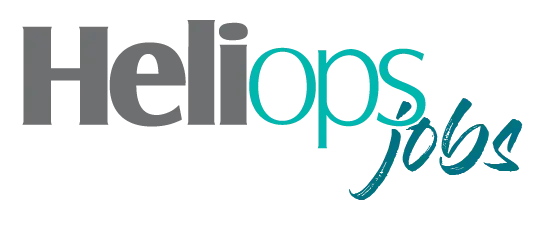Utilizing the technology of onboard cameras and extensive helicopter-based aerial footage, Australia’s 1986-1987 defense of the America’s Cup sparked a dramatic advance in what was achievable in live broadcast coverage. The 2021 event in Auckland, New Zealand relied extensively on helicopter-captured footage and showed just how far TV production technology and capability had evolved, producing what was undoubtedly some of the most spectacular yacht racing footage ever captured.
Technology
Leon Sefton, head of television production for the 36th America’s Cup (AC36) explained that the desired standard of TV coverage for the event required the development of new hardware and software solutions. These were handled by production partner Circle-O, particularly in areas such as the mesh communication network, augmented reality graphics hardware and systems integration.
Adam Brown and Matt Connor, owners of London-based Amis Productions which boasts a solid reputation for TV coverage of major international and Olympic sailing events, personally handled the aerial and camera-boat filming. Sefton’s history of participation in several previous Cup events meant he was familiar with many of the key players necessary to have onboard for successful event coverage and he commented, “With such a technologically advanced major sport as yachting, there is a core group of highly skilled people around the world that you need to bring into the production to guarantee its success.”
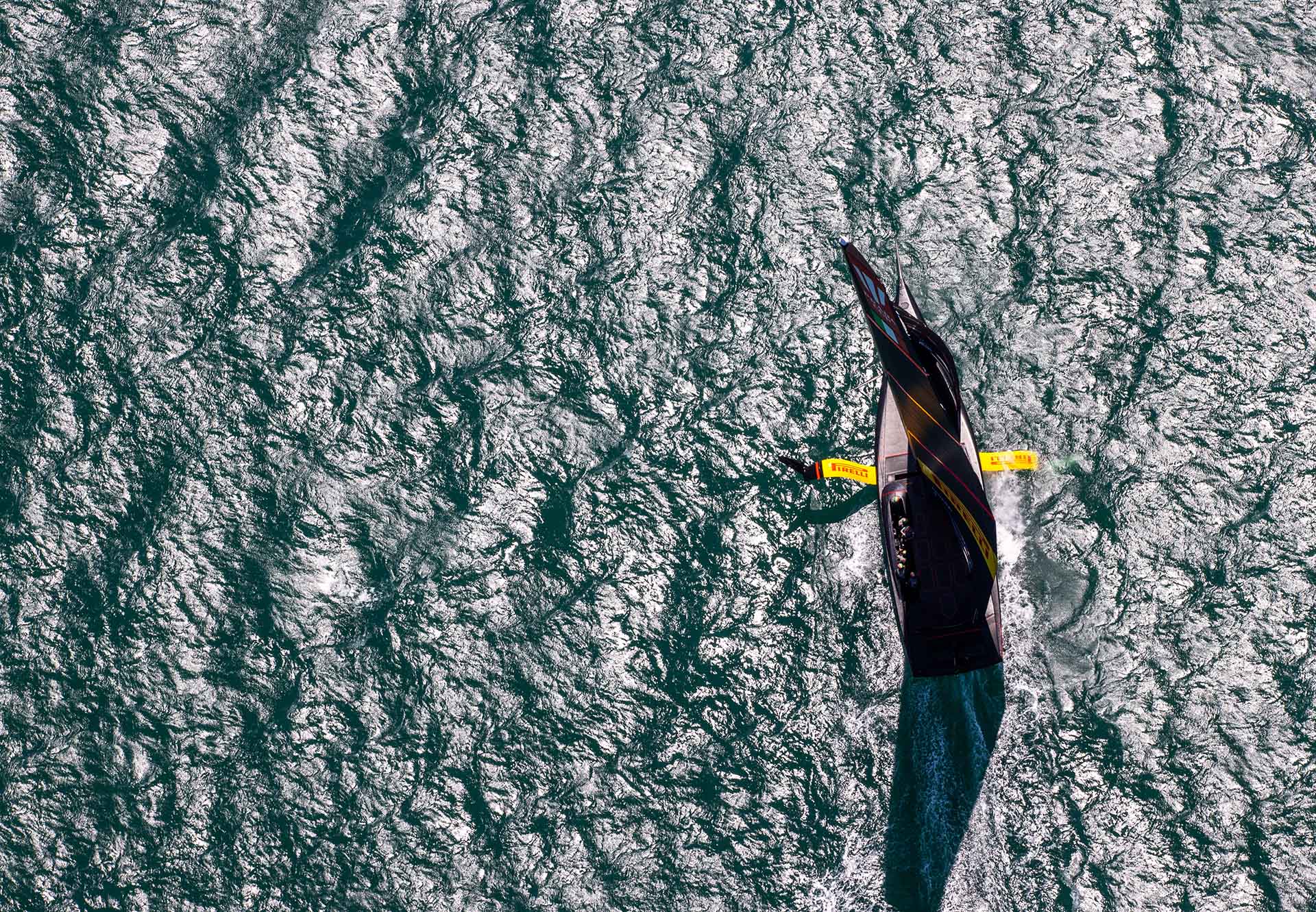
Helicopter Platform
As they can do for almost all outdoor sports, helicopters bring to yachting a wide, all-encompassing, overhead stadium view that offers viewers a perspective seldom achievable from ground-level shots, as well as a very dynamic close-up viewpoint of the action. Sefton greatly appreciates that capability, commenting, “Given the right pilot, camera operator, aircraft and camera equipment, it’s amazing just how dynamic and immersive a camera platform they can be, and how much they add to the coverage.” Kiwi pilot Tony Monk was a key member of the aerial filming effort and Sefton related being impressed in 2013, when he saw how comfortable and at one with his aircraft Monk was when operating in very close proximity to racing yachts, displaying an obvious and thorough understanding of avoiding aerodynamic interference with the boats and minimizing noise distraction to the crews. “With both chase boats and helicopters, it’s a golden rule that we don’t interfere with the racing in terms of wake, windage or avoidable distraction, so when it came to preparing for the 2021 event, it was a no-brainer that we needed him on our team sheet and he made a massive contribution in making sure we had the right people on staff for all aviation matters,” he stressed.
Monk worked with Sefton to compile a list of all operators in the local Auckland area and invite them to tender for the helicopter operation contract. He reported that despite the operation offering only around 250 flying hours in total, the scarcity of work due to the Covid-19 pandemic led to the submission of a very large number of extremely high-quality tender documents. Important factors that were considered when selecting the successful bidder included proximity to the event, availability of suitable AS350 aircraft and standby machines, suitably qualified and experienced backup pilots, on-site maintenance capability and support infrastructure such as fueling facilities and personnel. Cost was obviously also considered, and Monk stated that the Covid-induced lack of regular work led to bid pricing being substantially lower than would be expected in more normal market conditions. The contract was eventually awarded to Inflite Auckland, with Monk flying as the main pilot and having his choice of secondary pilot.
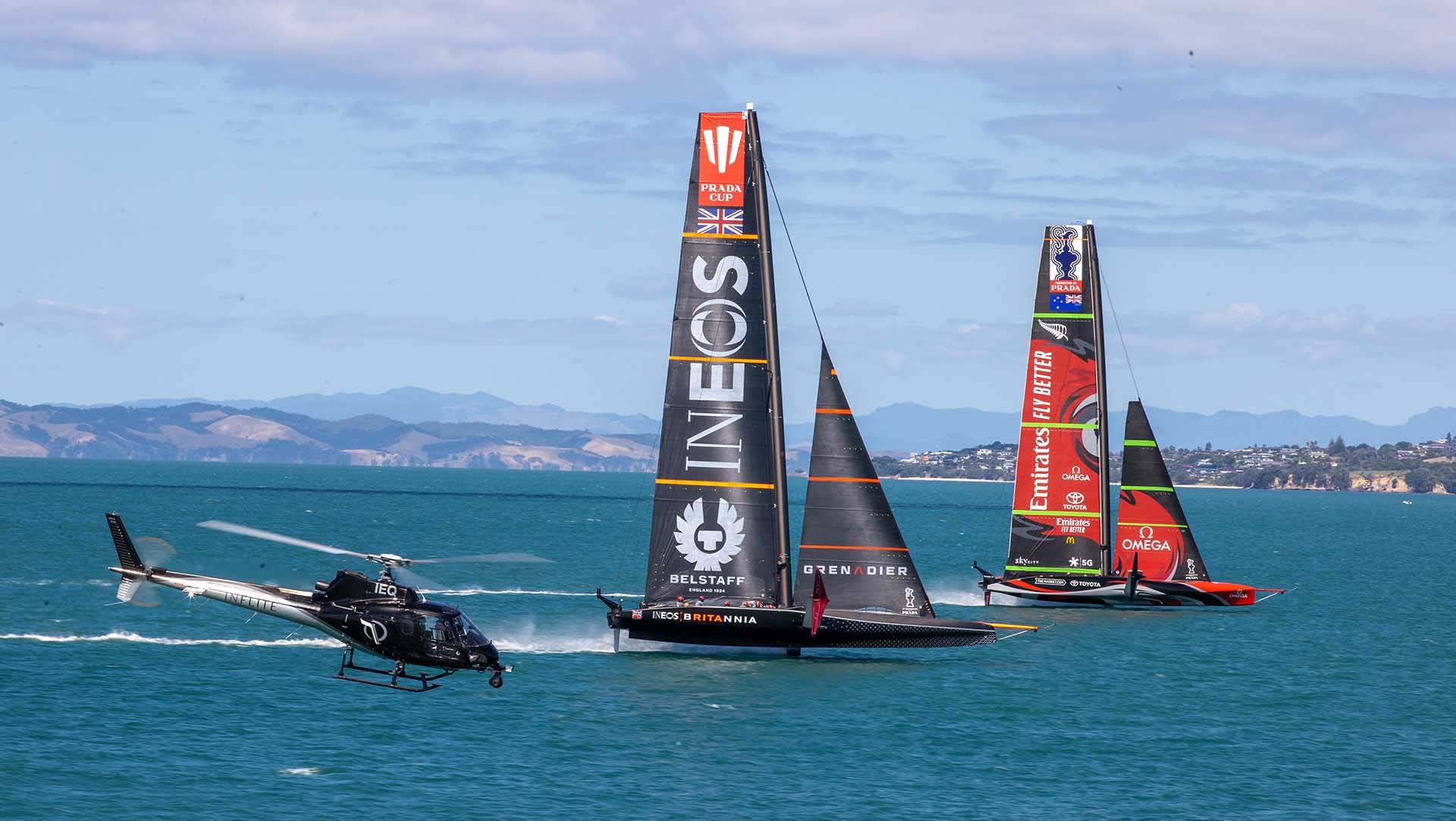
Equipment
One helicopter was used during the initial stages of the Prada Cup challenger series, with a second machine added during the latter stages and remaining throughout the America’s Cup series. Substantial equipment installation was required to fit the aircraft for the filming role, including an extremely accurate IMU (inertial measurement unit) in the Meeker AFSP-1 pole mount for the Shotover M1 6-axis gyro-stabilized gimbal platform, a laptop controller and two monitors for the Shotover system, a monitor for the pilot to see the current camera view, and equipment boxes on the rear seat to receive, combine and transmit the positional and video data of up to 4K-resolution from the camera and IMU to a number of on-ground receivers. A Riedel mesh server on every helicopter and race asset boat integrated them into the single combined communication network that intelligently transferred data and comm’s via the most effective route, utilizing any of the many mesh servers. The primary helicopter carried the augmented reality graphics system from Virtual Eye, the sports division of Animation Research Limited, a leading New Zealand graphics company. The Virtual Eye system provides graphical overlays for the field-of-play, allowing audiences to see such features as the sidelines, start line and other relevant overlaid information. The camera boat used for on-water filming was a wave-piercing design to minimize pitching and was fitted with a custom-built suspension mount for the gyro’ camera platform.
The high-resolution cameras mounted in the Shotover gimbal platforms boasted 46X zoom lenses with optical doubling, granting a massive zoom capability that allowed head shots of sailors from 1,000ft distance and obviously demanded camera operators with extensive experience and ability in a dynamic chase environment. Operating at rapidly changing altitudes between sea level and about 1,000ft, and from almost alongside the boats for close-up low-level imagery to high-and-wide panoramic shots, extremely high-level piloting skills were always vitally necessary and on full display.
Sefton explained that, because match racing is a two-boat contest, when two helicopters are used, one is constantly positioned for the high, wide field-of-play view, fitted with the augmented reality overlay system to give context and the overall racing situation. The upper-level machine’s camera was also fitted with a US$12,000 rain-spinner to prevent image degradation from raindrops, due to its wider field of view. The second machine was an action-mode platform, acquiring close-up detail of the yachts and their crews. Chase boat filming had its separate challenges and despite the camera boat’s 38kt top speed, a speed deficit of around fourteen knots to the racing yachts meant that an exceptional skipper was necessary to avoid conflict, while still obtaining the desired footage. Brown said that Sefton was quite insistent that he and Connor came in person to the event, explaining that his close working relationship with chase-boat driver Clint Jones had developed over many years and built a combined standard of trust, familiarity, knowledge and competence that minimized any chance of on-water conflicts or failure to achieve the desired end product, while Connor flew as camera operator in a helicopter with Monk.
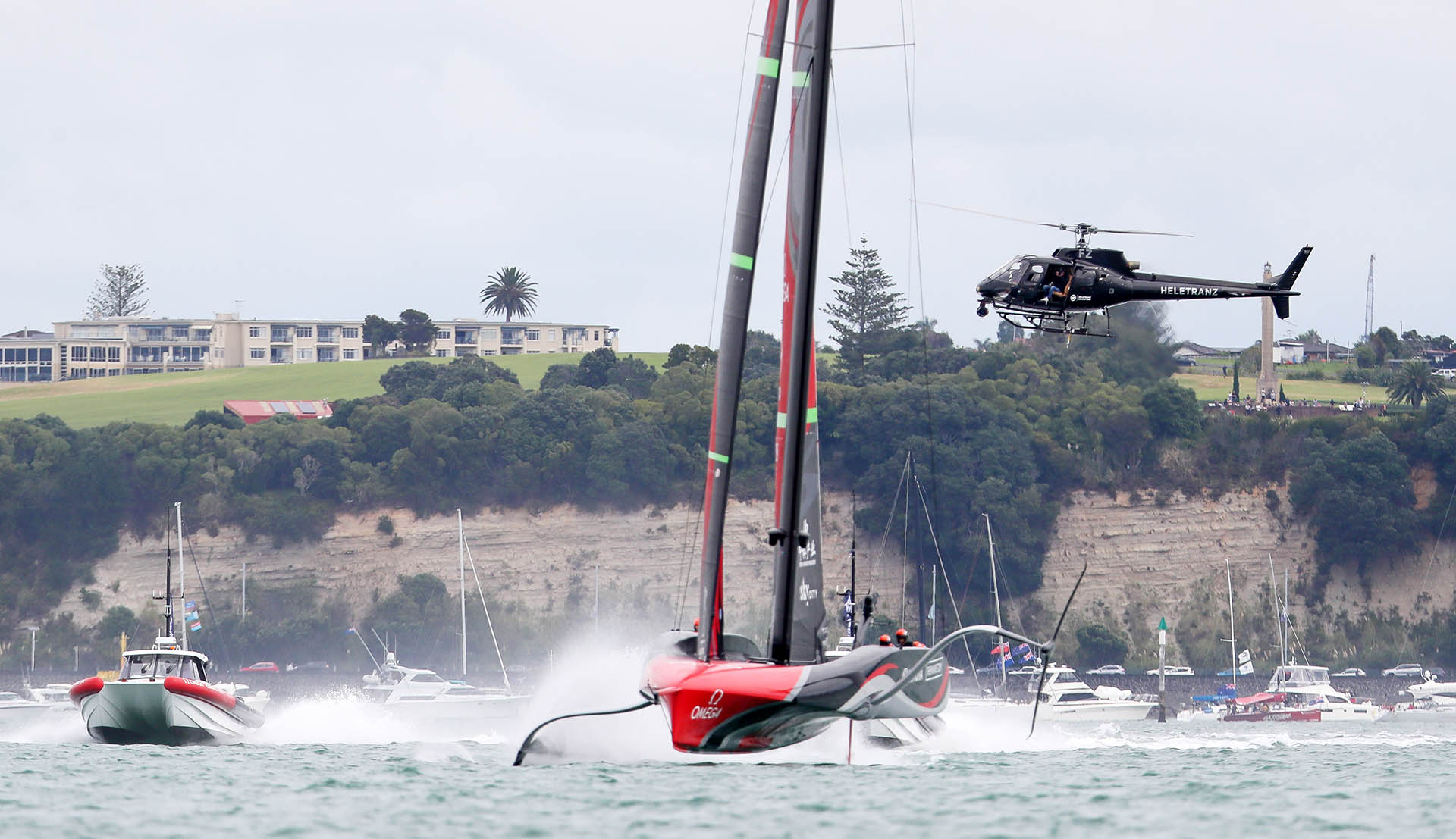
Getting the Regulator Onside
Auckland aviation stalwart and secretary of the airspace user’s group, Qwilton Biel was one of the people that Monk and Sefton wanted on the team and with his extensive experience in orchestrating and managing aviation operations and compliance for several previous America’s Cup regattas, Whitbread races and Volvo Ocean races. Biel was the ideal man for that role for AC36. “We determined our roles on the basis that I can’t fly as well as Tony, and he can’t do paperwork as well as me,” he quipped. Biel started to organize air operations around two years prior to the commencement of the regatta and his input and experience was key to achieving a satisfactory arrangement with CAA – New Zealand’s civil aviation administration – regarding airspace restrictions during the event that enabled effective operations, while minimizing disruption to other operators in the region. The outcome was that three restricted airspace areas from sea level to 2,000ft were defined, covering the different potential racecourses and with only one being activated on any given race day, in addition to a restricted area over the Cup Village that was permanently active for the entire duration of the event. Three circuits were run over each race, as Biel outlined. “From sea level to 1,000ft was for the surface broadcaster, where you saw Tony and his team operating in what was their exclusive piece of sky to get the footage they needed. CAA wanted to split fixed and rotary-wing operations in the airspace, so we also ended up with a 1,400ft seven-helicopter circuit and a 1,800ft fixed-wing circuit for up to five aircraft.”
Reaching agreement with CAA on a fair and workable arrangement for other aircraft was a lengthy, detailed process that involved not only an extensive safety-case written by Biel and peer reviewed by Larry Bennet, Toby Clark and Tony Monk, three of the most highly regarded and event-experienced aviation operators in New Zealand; but also consistent pressure was applied by local operators to their CAA contacts. Drones were also permitted to undertake restricted operations within the airspace and Biel expressed much respect for the drone community, describing them as ‘a delight to deal with’ during consultations for establishing airspace management. “Without exception, all they wanted to do was comply and for it to work for both us and them,” he remarked. The restricted areas were geo-fenced to prevent unauthorized drone incursion and when drones were filming during events, they were required to remain within thirty meters of the boats, while the helicopters had to stand off at least fifty meters. Drone activity ceased early in the racing series however, and the helicopters then had the broadcast circuit to themselves without that restriction. As part of the airspace management plan, Biel himself was on site in the on-water operations center whenever the restricted airspace was active, to oversee flying over the event.
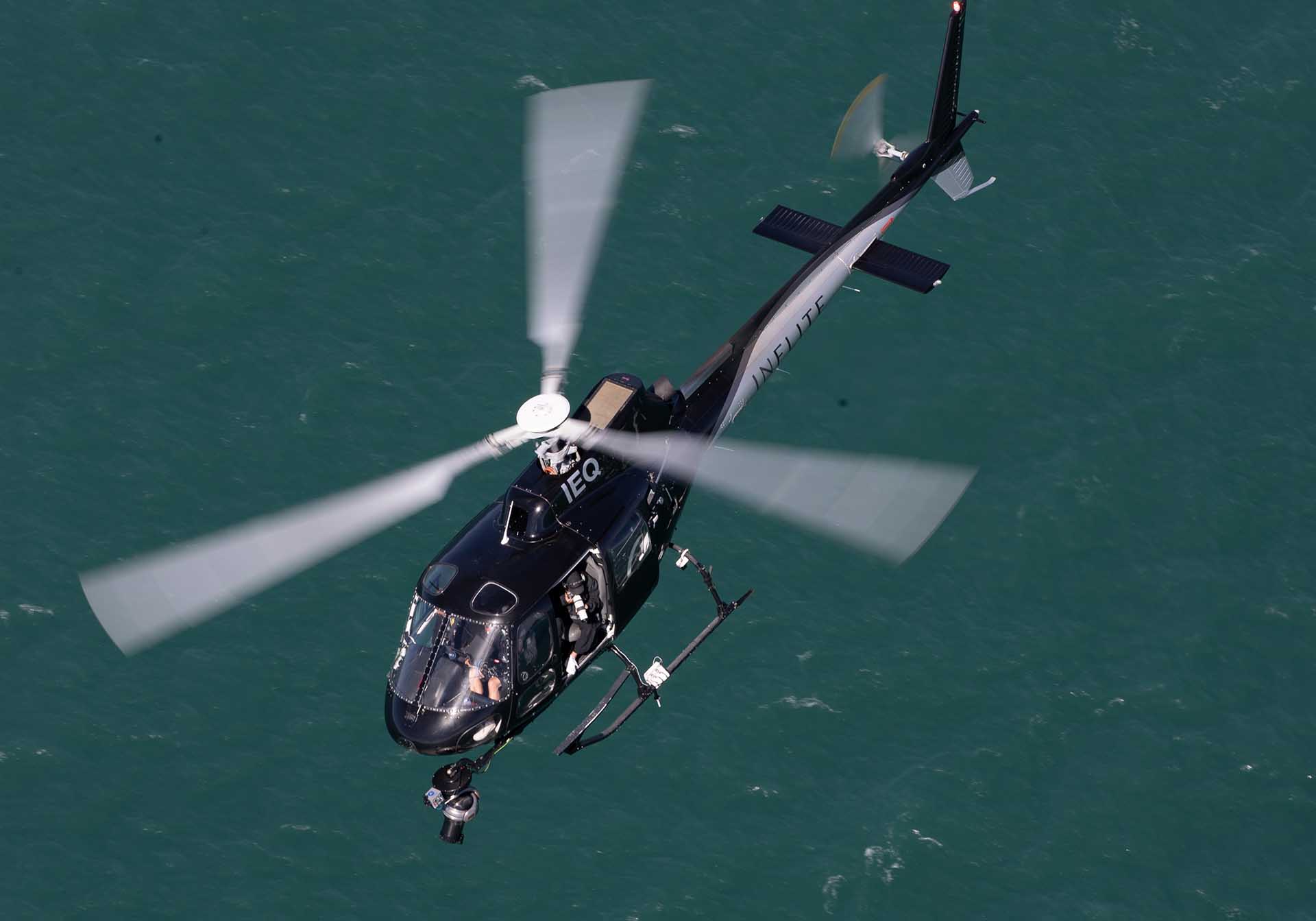
Experience
An AS350-FX2 was the first aircraft used during the event, and Monk considered it to be an excellent platform for the task. He commented that Inflite provided exceptional service, with everything on hand as needed. “It worked perfectly, and everyone pulled all the stops out to make it happen. The engineers were standing by on site and ready for any maintenance needs, and as soon as we came back, they were ready to hot-refuel us.” The flying for this event did, however, come with an added complication. For the first time in AC coverage, it was required that the stills photographer was included on the filming aircraft as it was deemed to be too dangerous to insert a third helicopter into the airspace just to carry him. Monk drily understated that it made the flying ‘a bit more interesting’, commenting, “As you can understand, that cameraman was only on the correct side of the aircraft for half the course, which meant there was a lot of unusual flying required to get him into position for his shots.”
Brown and Connor share backgrounds as cameramen with extensive experience successfully shooting major sporting events, particularly yacht racing. Exposure to the capabilities of gyro-stabilized camera platforms for aerial photography led to their purchasing their own unit and eventually building a group of companies that specialize in a range of aerial photography markets. “After years and years of hanging outside helicopters, being battered around using handheld stabilized gear, we realized that to do our job properly we needed to move ahead. Our first unit was a FLIR Ultramedia II that we bought secondhand for around US$300,000, and when we won the tender for the 34th America’s Cup in San Francisco we then had to go out and buy five brand new systems; two FLIRs and three Cineflexes. That was the biggest risk the business has ever taken, borrowing that amount of money to satisfy the contract. We put three Cineflex units in the air and used hermetically sealed FLIR systems on the water because they’re just so robust,” Brown related. “As the boats get faster and faster, the gyro-stabilized platforms become absolutely necessary,” added Connor, “because there’s no way you can effectively shoot with a handheld camera out of a RIB doing forty or forty-five knots. When you look at the images we get now, they’re rock solid and as a viewer, that’s what you need.” He explained that a camera operator can make a reasonable living using their skill to shoot images, but the substantial revenue stream of a successful company comes primarily from equipment rental. “Stepping up to that many systems transformed us into a company that could supply the equipment and expertise in-house that is needed to take on the biggest major events, and there are only a few companies that can do that.” Brown stated that Amis treats its equipment in much the same manner that aircraft are maintained, with strict care and servicing, and parts replacement before breakage to ensure reliability.
Using gimbal platforms from Queenstown-based Shotover for this event gave the added advantage of being in the same time zone as the equipment manufacturer, who also provided a technician to the event to assist with installation and integration of the equipment. Shotover modified Amis’ M1 platforms with a unique ‘labyrinth’ system that enables daily purging of the enclosed atmosphere, letting the housed cameras breathe and remain cool, while preventing the ingress of water, an absolute necessity in the corrosive operational environment of low-level over-water filming of high-speed racing yachts. Simulated graphics development has paralleled the advances in aerial photography and Brown remarked that Animated Research Limited’s on-water augmented reality graphics have become an industry standard in how to make sailing coverage completely understandable to viewers. “They’re geniuses at design and making it look perfect. Integrating it with the live picture has been a real step forward and a massive bonus for the public’s comprehension of the sport,” he opined. The graphics program does, however, add a layer of difficulty for camera operators. Years of experience teach a photographer how to frame a great shot, but now a margin must be left available in certain areas of a shot to allow for the graphics overlay. That is somewhat counter-intuitive for an experienced cameraman and adds to the complexity of their task, although technology is developing that provides the camera operator with displays to give him visual clues to the look of the overlaid end result.
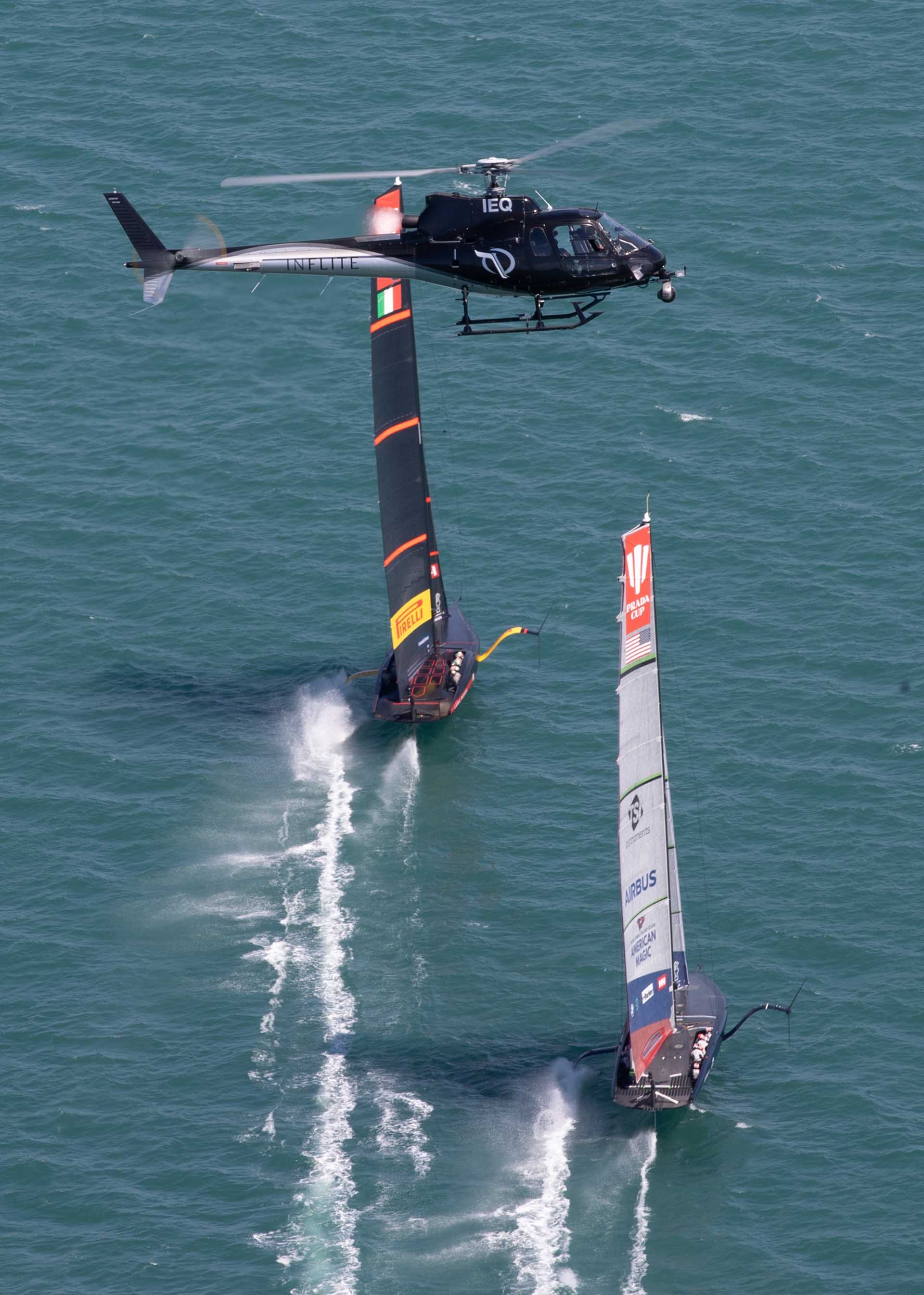
Program
Each race day commenced with a full briefing for the boat crews, production team, photographers, spotters and aircrews, after which a test flight was conducted, flying over the course, testing all the equipment, camera systems and the helicopter’s operability and performance. “After that we’d shut down for an hour or two and get airborne again about fifteen minutes prior to the start of that afternoon’s race to get the opening shots,” Monk explained. “During the morning briefings we were told the course selection for the day, and we discussed what could be improved from the previous day’s shots, which side of the course we would be starting on, the shots they would attempt to capture during that day’s racing, and the positioning of the upper and lower filming aircraft. So, when we flew out, we’d record any action we could see, show the course and all the spectator fleet heading out and get the opening shots. We knew what side of the course we’d be flying on and which boat we’d be focusing on, with the chase boat concentrating on the other boat. A lot of that was predicated on the sun angle, so the cameraman was not shooting into the sun and Matt always seemed to want me to get as low as I could go.” He also explained that each aircraft flew with a spotter on board to keep ‘eyes out’ and ensure separation and safety. “That was crucial because when we’re flying, we’re acting more to support the camera operator than being a pilot, concentrating on our downwash, the race boats, the chase boats and trying to give the cameraman the shots and angles he wants because he’s always trying to line up two boats.”
Monk, Sefton, Brown and Connor all concurred that the considerations that go into creating great television footage are not, and shouldn’t be, obvious to the viewer. Such factors as horizon positioning, smooth transitions between subject matter in the frame, the direction and placement of multiple boats in a shot and general composition are the cameraman’s stock-in-trade, but when appropriately understood and addressed by a skilled operator, the resulting imagery looks amazing to the viewer, who probably never appreciates just why the picture looks so good, or what was involved in obtaining it. Small details can have a massive impact on the viewer experience. When both boats are in a shot, for example, it is important to have the leading boat ahead in the picture even though it may not look that way on the water, otherwise viewers get a false impression of the race’s progress. “To a pilot it means a lot of backwards and sideways flying,” Monk elaborated, “so the spotter has an aviation background and is there to monitor the bigger picture; the other helicopter, altitudes and spectator boats etc. to keep us within our safety margins.” Pilot and cameraman are in constant communication to achieve the desired positioning and the cameraman is also being advised by radio of imminent action that may require filming, enabling him to smoothly transition to a different shot or composition. During air operations Biel added an extra layer of safety by monitoring the airspace and would advise the pilots by radio of any traffic or airspace issues that arose.
“All the camera assets are under the control of the director Wayne Leonard, a highly accomplished multi-camera director with experience that includes a number of America’s Cup series. There are about ten cameras on board each yacht, plus the two helicopters and the chase boats, so there’s a lot of camera firepower to work with and every camera angle does a particular job,” advised Sefton. “Helicopters provide a mix of geography and action, and the chase boats do the same but also give a superior sense of boat speed.” He commented that the bar for production quality had been set very high at the 35th AC regatta in Bermuda, so the goal for the production team had been to match or better the quality from those events. “Bermuda was a really slick production. I think we matched that, and we took the game even further forward in some areas, which is our responsibility.” The racing skippers wore microphones to access the production power of the television team, enabling them to communicate any concerns about safety or racing interference immediately and directly to the TV director. Sefton also pointed out that the continually increasing boat speeds attained as racing yachts evolved also increased the risk level for both chase boats and aircraft conducting close filming work, highlighting the importance of extensive experience in the race coverage environment.
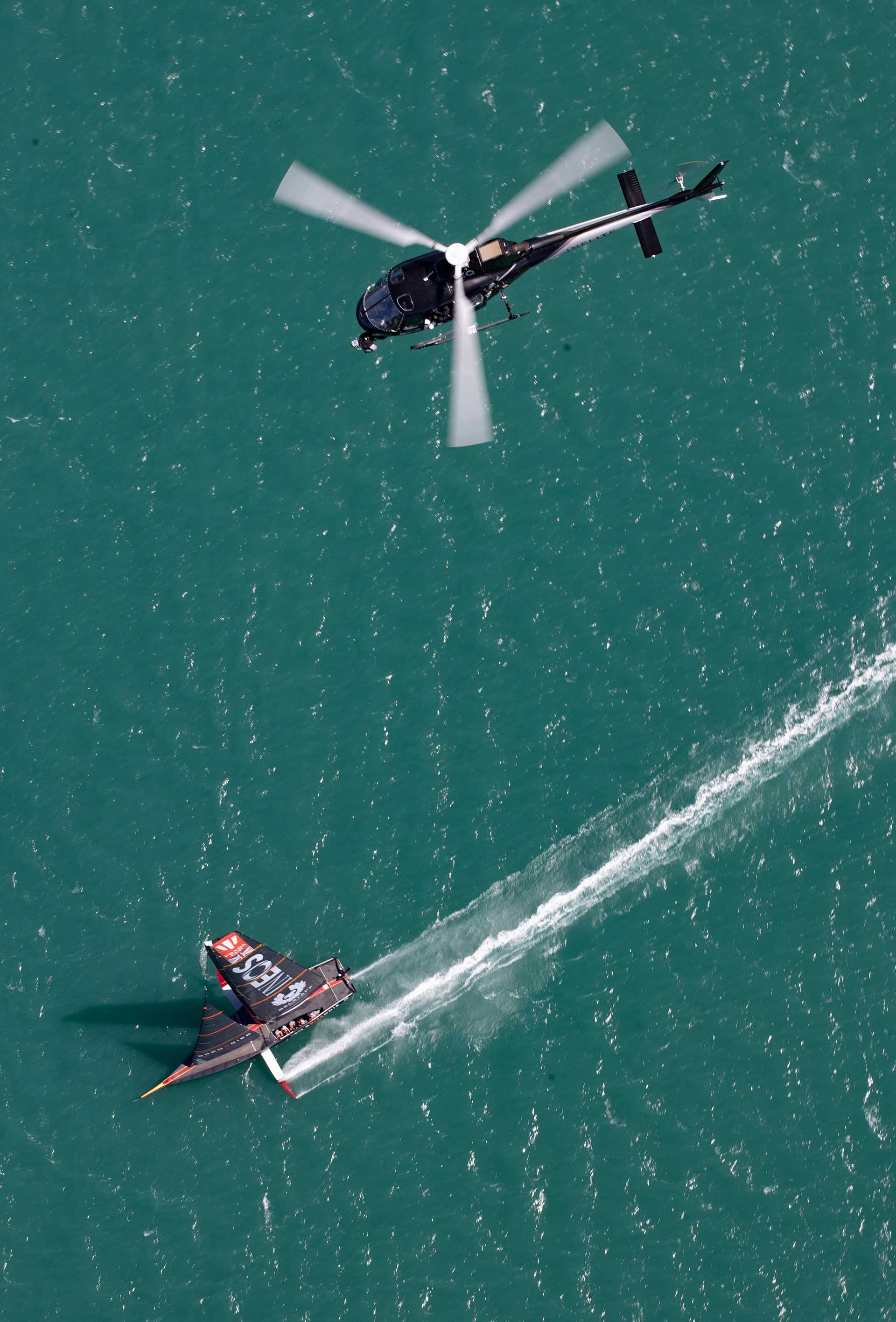
The Challenge
Connor considers that filming yacht racing from a helicopter is the most satisfying, but most dynamic and challenging flying there is for a cameraman. “Stuck on the end of the camera alongside a yacht doing fifty knots, while the helicopter’s going sideways at eighty knots is interesting, to say the least. And no two days are ever the same in sailing,” he stressed. Brown added, “It’s exciting and there’s a lot of adrenaline. In live TV you only get one chance for a shot, so you have to be in the right place at the right time. It’s a real challenge to pull it off and come out at the end of a full day’s broadcast incident free.” Biel described the conduct of aviation activity during the event as a credit to everyone who had flown, remarking that he had expected nothing less from the locals. With no major infractions or intrusions into the restricted airspace, the aviation aspects of AC36 ran exceptionally smoothly and this success was largely due to the entire Auckland aviation community’s wholehearted support and willingness to work together cooperatively, which was noted and appreciated by all those concerned with operating AC36’s airspace. According to Sefton, the viewing audience for the 36th America’s Cup was the highest ever recorded since the beginning of televised coverage, and many are of the opinion that some of the coverage captured during AC36 is the most spectacular in the event’s history. “It’s a privilege working on an event where everybody is the very best in their particular trade or area of expertise,” Monk opined. “It has been an immensely enjoyable event to be involved in. It was home-based and challenging but unlike most events, they had a realistic budget, plus there were plenty of hours, fantastic equipment and truly great people to work with, in whom we could have complete confidence.”
 HOME
HOME